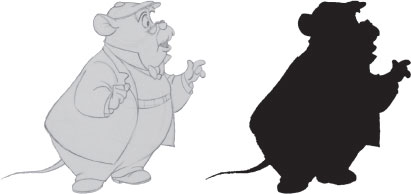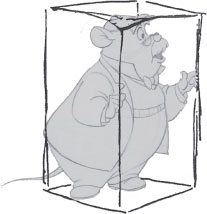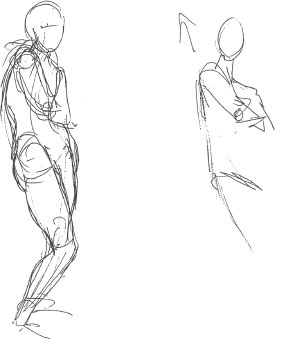No, I am not trying to lead you astray. “Cheating” in drawing is a term used when some part of the figure is adjusted to help make the pose read more clearly. One of the most obvious places to introduce a cheat is in establishing a good silhouette. First, let’s look at a drawing with a fairly good silhouette.

This drawing of Dawson clearly defines his hat, nose, mustache, mouth, hand, coattail, legs, etc. The stance, mood, and personality are unmistakable. Incidentally, the third dimensional elements in the drawing work equally well in making it a readable drawing.

If the drawing had not been so successful, “cheating” a little here and there would have helped. For instance, the coattails, the fingers, or the hat could have been lengthened or in some way made more obvious. Let’s take a less clear silhouette and see if it could be improved without substantially changing the pose. In the first attempt Dawson’s left elbow was extended to avoid the tangent it was forming with the back side. His right elbow was shortened to expose more cheek, and the tip of the hat was more clearly defined. In the second attempt the left arm was shortened and the backside extended (the opposite from the first) with a little of his shirttail extended, which helps to divide and define the upper body from the lower.

The fear of straying from what is before you while drawing from the live model can sometimes “tie your hands” (your drawing hands). An innocent little cheat may do such wonders for your drawing that any deviation from the “facts” will go unnoticed. A good place to practice cheating is while drawing from the human figure. Very often in a classroom situation you will be stuck with a difficult angle where things that explain or complete the gesture are hidden from you. The challenge of adjusting the pose to better tell your story can be invigorating. The important thing is you are not bound to copy what is before you, but on the contrary, you are bound to tell the story of the gesture, even if you have to cheat to do it.
Caricature, one of the animator’s most valuable tools, is a total cheat. An effective caricature can be so exaggerated that not one line of realism remains. Even so, a good caricature can be more “real” than a photographic copy. Tracing photostats for a scene of animation is sufficient proof of that.
So start now. Discover that creative freedom that releases you from the conventional copycat type of seeing, thinking, and drawing — become a good cheater.
I saved two drawings from the evening class that may help to illustrate the point. In the first one, the model had assumed a rather haughty, officious air. It was subtle and the drapery was no help at all. One artist got trapped in the multitude of curves in the clothes and figure, and in attempting to copy what was there, missed the aloofness of the gesture. In my suggestion, I “cheated.” I took out all the curves (I have a tendency to go to extremes when pointing out things like this), thrust the shoulder up, straightened out the hanging shirttail (thus accenting the shoulder lift), stretched the neck, and added a better angle to the folded arms, and voila — instant arrogance.
The other drawing was again from a deceptive pose, in that the clothes contained a lot of soft curves. In cases like this, one has to cheat a little and introduce what they know is happening rather than what they see. For instance, in this pose the girl’s right shoulder had to lower in shape as well as position, the front of the neck had to stretch to reach from the raised chin to the lowered pit of the neck, and the coat had to hang with some straights to contrast with the bunched up cloth at the elbows.


